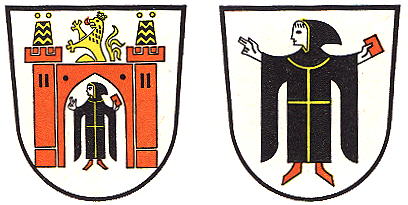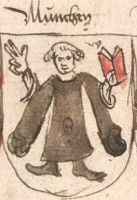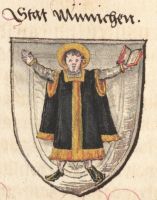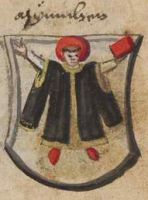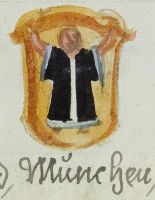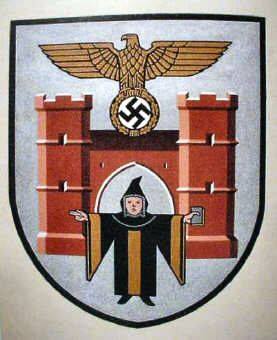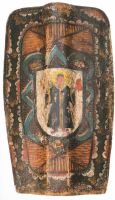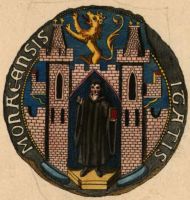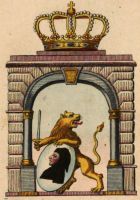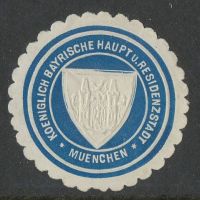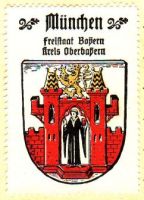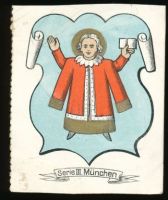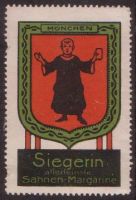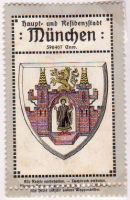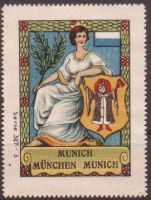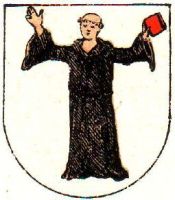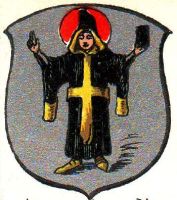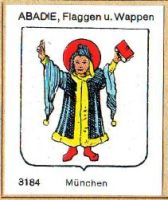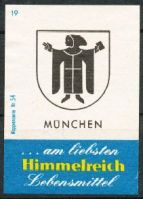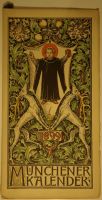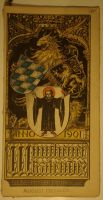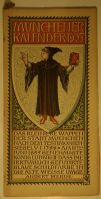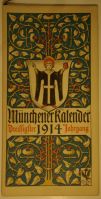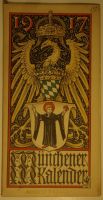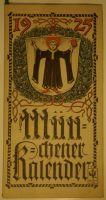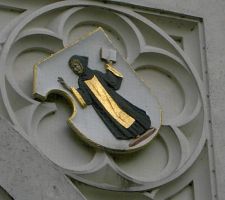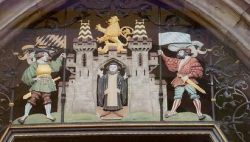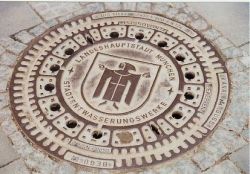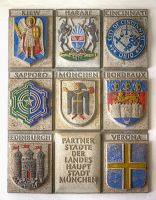München
MÜNCHEN
State : Bayern
Urban district (Stadtkreis) : München
Additions : 1854 Au, Giesing, Haidhause; 1864 Ramersdorf; 1877 Sendling; 1890 Neuhausen, Schwabing; 1892 Bogenhausen; 1899 Nymphenburg; 1900 Laim, Thalkirchen; 1912 Forstenried; 1913 Berg am Laim, Milbertshofen, Moosach, Oberföhring; 1930 Daglfing, Perlach; 1931 Freimann; 1932 Trudering; 1938 Allach, Feldmoching, Großhadern, Ludwigsfeld, Obermenzing, Pasing, Solln, Untermenzing; 1942 Aubing, Lochhausen
| German |
|
| English | Argent a monk statant habited Sable trimmed Or with shoes Gules [arms outstretched] the right hand in benediction the left holding a book Gules. |
Origin/meaning
The arms were officially granted on June 11, 1865, December 24 1936 and again on December 17, 1957.
The city of München presently only uses the right arms as the official arms. Until 1957 the left arms were the official great arms, the right arms the arms for daily use.
The monk (Mönch) is a canting symbol. The monk already appears as a canting symbol on the first seals of the city, which date from 1239 and 1268. The seals show a gate with the monk and above the gate the imperial eagle, probably derived from the arms of the Bishops of Freising, who were free imperial rules (i.e. immediately subordinate to the King/Emperor), to which the city belonged. Since 1313 the lion replaced the eagle, as the city now was a possession of the Wittelsbach family, Dukes of Bayern. The lion is the oldest symbol for the Wittelsbach family, which commonly used a blue shield with silver diamonds (see the arms of Bayern).
The seal of München from 1330 (source)
The arms in a manuscript from 1599
The arms in a 16th century manuscript
| The seals of München by Hupp, 1912 |
The arms with the gate have not changed since and were officially granted as city arms in 1834 by King Ludwig of Bayern. Form 1936-1945 the lion was replaced by the eagle used by the Third Reich.
| The arms from 1936-45 |
The use of the great arms was abolished by law from December 17, 1957 and only the small arms have been used since.
The monk as a single figure has been used on a small seal dating from 1304, and on the banners of the city since the mid 14th century. The shape of the monk has changed considerably during the centuries.
More images of the arms
The small arms in the Kaffee Hag albums +/- 1925
The large arms in the Kaffee Hag albums +/- 1925
The arms in the Continentale Verlags-Anstalt album, +/- 1910
The arms in the Abdulla album, 1928
The arms in the Abadie albums
The arms on the Karlstor Gate (source)
Literature: Stadler, 1964-1971, 8 volumes.
This page is part of the German heraldry portal Deutsche Wappensammlung |
Heraldry of the World |
|
German heraldry:
|
Selected collector's items from Germany:
|
Contact and Support
Partners:
Your logo here ?
Contact us
© since 1995, Heraldry of the World, Ralf Hartemink 
Index of the site
